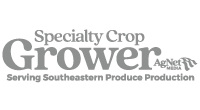By Ramdas Kanissery and Mahesh Bashyal Using compost and soil amendments is beneficial to Florida citrus groves. Florida soils are sandy and have a low organic matter and cation exchange capacity. Adding compost and organic amendments (e.g., humic acid) can enhance the soil’s ability to retain water and nutrients. These practices can also boost soil microbial activity and improve soil …
Keeping Trees Healthy After Removing IPCs
Researchers and growers have found that individual protective covers (IPCs) can keep young trees free of HLB for two or more years while providing additional benefits like improved tree growth. The IPCs work by keeping HLB-infecting Asian citrus psyllids out of the tree canopies. But trees outgrow the covers and must eventually be removed. Researchers have found that about 60% …
Refreshed Format for Florida Grower Citrus Show
Over the years, the Florida Grower Citrus Show has become the premier event for growers on the East Coast of Florida while drawing growers from other key production regions as well. Last year, AgNet Media purchased the assets of Florida Grower magazine. With that transaction came the show. Since that time, the team at AgNet Media, along with its partners …
Old Variety Gets a New Look
The Parson Brown is an early-season sweet orange that J.L. Carney identified in 1875. By the 1920s, the variety had become a popular cultivar among growers, but eventually plantings declined as Hamlin became the go-to selection for the early season. However, because of its apparent tolerance to HLB, Parson Brown is again stirring interest among growers. Manjul Dutt, assistant professor …
Trunk Injection for HLB: What You Need to Know
Some Florida citrus growers have recently started oxytetracycline hydrochloride (OTC-HCl) injection into tree trunks to help manage HLB. Other growers are considering it. Researcher Ute Albrecht offered a list of best practices for the product’s use during a Jan. 31 presentation in Immokalee. The presentation was made at the University of Florida Institute of Food and Agricultural Sciences Southwest Florida …
Key Terms to Know When Using Pesticides
By Ajia Paolillo Editor’s note: This article grants one continuing education unit (CEU) in the Core category toward the renewal of a Florida Department of Agriculture and Consumer Services restricted-use pesticide license when the accompanying test is submitted and approved. As a certified restricted-use pesticide applicator, it is your responsibility to use pesticides safely, not only for yourself but for …
Sting Nematodes and IPCs
By Larry Duncan and Fernando Alferez Newly planted citrus trees are far less tolerant of pests and diseases than when mature. Sting nematode (Belonolaimus longicaudatus) was not considered a serious economic threat to Florida citrus until successive hard freezes in the 1980s caused widespread replanting of groves. Patches of stunted, declining trees caused by the irregular distribution of sting nematodes …
CRDF Board Off to a Busy Start in 2023
The Citrus Research and Development Foundation (CRDF) kicked off the year with its monthly board meeting in January. The board invited three researchers who had submitted pre-proposals to submit full proposals during the meeting. One proposal will study if the ingestion of oxytetracycline hydrochloride (OTC-HCl) will minimize the amount of Candidatus Liberibacter asiaticus (CLas) in the gut of “hot” (or …
Considerations for Managing Citrus Black Spot
In Florida, citrus black spot (CBS) is present primarily in commercial groves in five southwest counties (Charlotte, Collier, Glades, Hendry and Lee). The disease can cause up to 60% yield loss in severe situations with little management, researcher Megan Dewdney reported in January. More commonly though, growers with infestations experience fruit drop levels of 10% to 20% in a minimally …
Sneak Peek: February 2023 Citrus Industry
With more growers incorporating compost and organic amendments into their production, weed management is receiving increased attention. University of Florida Institute of Food and Agricultural Sciences (UF/IFAS) authors Ramdas Kanissery and Mahesh Bashyal take on this topic in their article in the February 2023 issue of Citrus Industry magazine. While compost and organic amendments can increase soil health and boost …
Planning Your 2023 Pest Management
By Lauren Diepenbrock Pest management is a year-round challenge in Florida citrus. With the warm climate, pests are at the ready as soon as plant resources are available to them. With knowledge of insect and mite biology in relation to tree phenology, plans can be developed to protect fruit and maintain productive citrus trees. Populations of some highly problematic pests …
All In For Citrus Podcast, January 2023
The January All In For Citrus podcast kicks off 2023 with a recap of a recent citrus program on gibberellic acid as well as a preview of a host of upcoming events. Michael Rogers, director of the Citrus Research and Education Center, provides details on the various seminars scheduled on topics ranging from trunk injection to the new and improved …
Investing in Artificial Intelligence
By J. Scott Angle, jangle@ufl.edu, @IFAS_VP University of Florida Institute of Food and Agricultural Sciences (UF/IFAS) breeders produce new citrus plants more quickly than they can figure out if consumers like how the new fruit varieties taste. In the race to create versus evaluate, creators lead evaluators by hundreds of individual plants at a time. It takes a post-doc a …
Updates on Florida Citrus Diseases
Researcher Megan Dewdney recently provided updates on citrus canker, postbloom fruit drop (PFD) and algal spot. Dewdney is a University of Florida Institute of Food and Agricultural Sciences associate professor of plant pathology at the Citrus Research and Education Center. CANKERFruit is most susceptible to canker when it is from 3/8 to 1.5 inches in diameter, Dewdney said. The fruit’s …
Artificial Intelligence to Assess Crop Damage
University of Florida Institute of Food and Agricultural Sciences (UF/IFAS) researchers plan to use artificial intelligence (AI) technology to quantify damage to fruits and vegetables caused by extreme weather events. One such extreme weather event was Hurricane Ian, which struck Florida on Sept. 28, 2022. The storm’s damage to all crops, livestock and aquaculture products was initially estimated at up …
Citrus Leaders Provide Disaster Testimony
Florida agriculture took a wallop from Hurricane Ian last year. Throw in another hurricane (Nicole) and a freeze, and the disaster losses stacked up. The state’s citrus industry took a particularly hard hit. On Jan. 17, citrus industry representatives headed to Tallahassee to testify before the Florida Senate Agriculture Committee about the toll these weather events had on an already …
Postharvest Water Requirements for Packers
By Clara Diekman, Micah Gallagher, Taylor O’Bannon and Michelle Danyluk Compliance dates for all water associated with the Produce Safety Rule (PSR, Subpart E) has previously been delayed, pending completion of the rule. The U.S. Food and Drug Administration (FDA) announced in the fall of 2022 that postharvest water requirements in the PSR will be enforced on large farms beginning …
The Promise of Gibberellic Acid
Researcher Tripti Vashisth shed additional light on the promise of gibberellic acid (GA) applications in rejuvenating HLB-affected orange trees during a Jan. 11 presentation. Some of the important messages that the University of Florida Institute of Food and Agricultural Sciences associate professor highlighted were: VALENCIA TRIALIn a 2016 to 2022 Valencia field trial, GA applications made from September to January …
Trunk Injection Not a Silver Bullet for HLB
Although trunk injection of oxytetracycline hydrochloride (OTC-HCl) has received much recent press for its promise in managing HLB, there is still no silver bullet for the devastating disease. That was part of plant pathologist Ozgur Batuman’s message at a Dec. 10 seminar addressing HLB and other citrus diseases that may exacerbate HLB’s effects on trees. “There is no single effective …
Get the Timing Right for Gibberellic Acid Applications
By Tripti Vashisth Since 2021, a number of Florida growers have adopted the use of gibberellic acid (GA) in their grove management programs. This widespread adoption is due to the fact that GA-treated trees show canopy rejuvenation and reduction in preharvest fruit drop, resulting in improved yields. The research on Valencia shows that the effect of GA improves over time. …





























